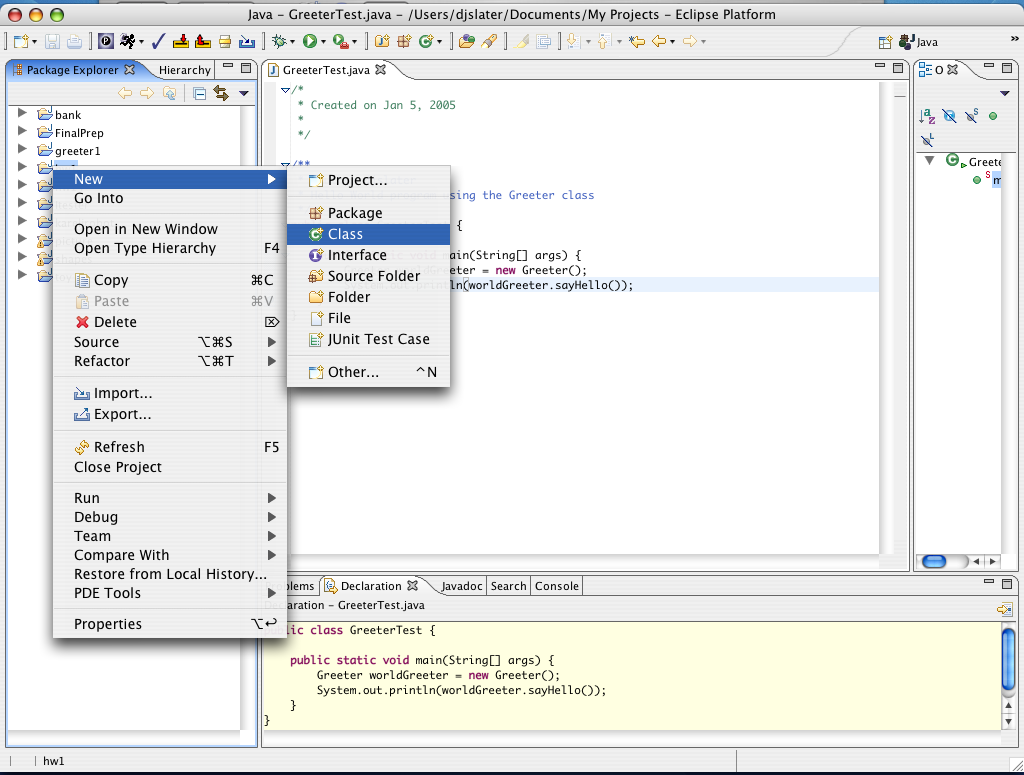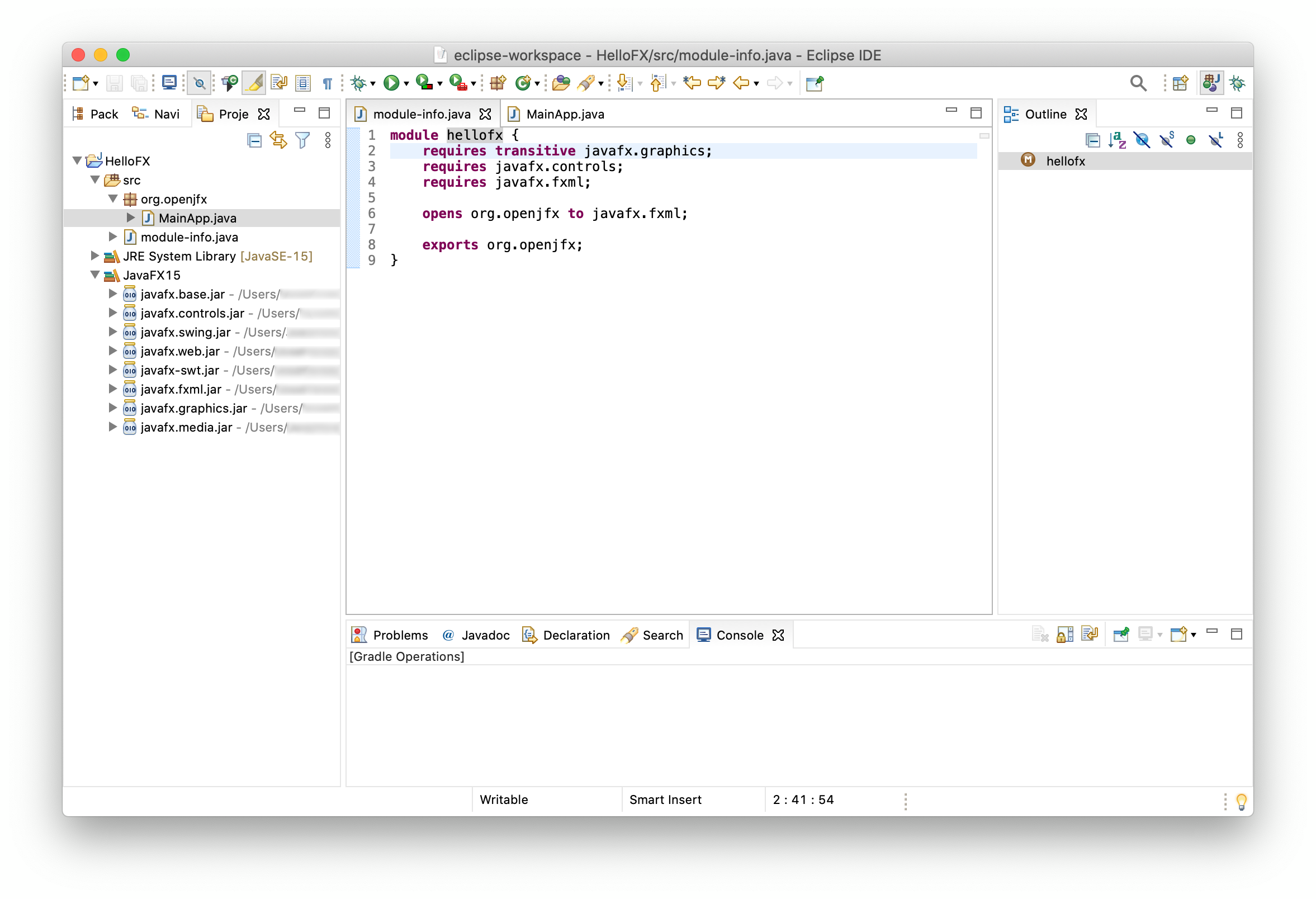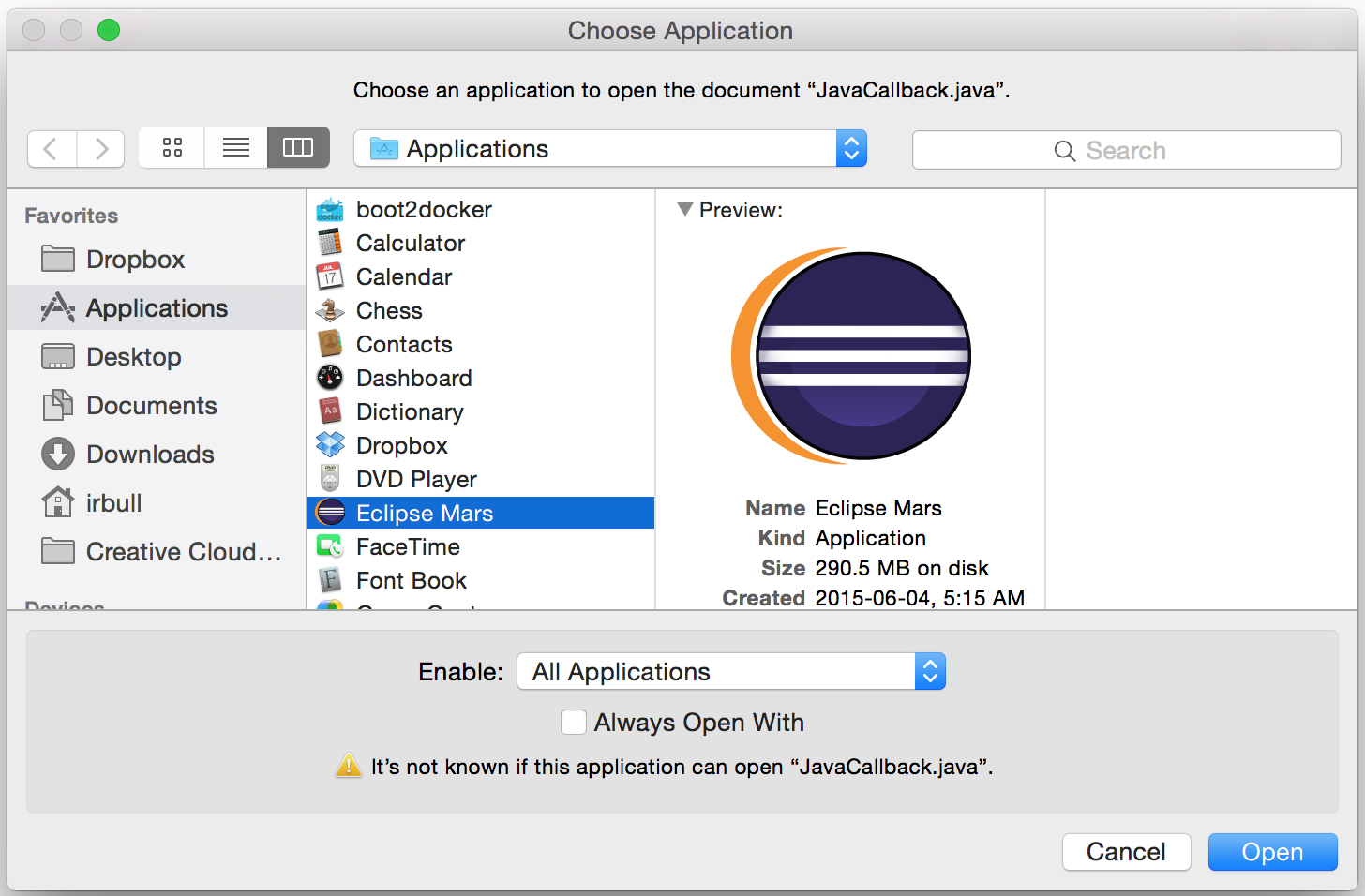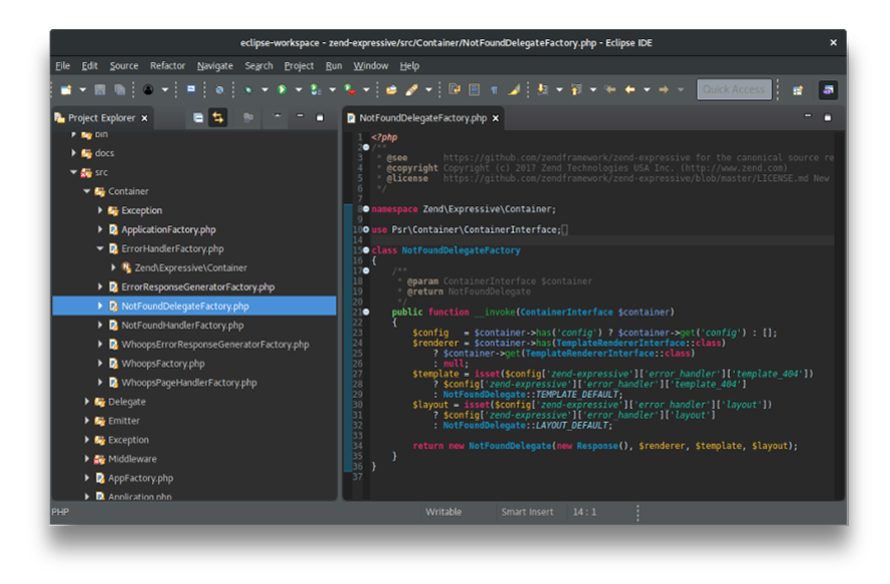- It is also possible to add Javadoc to a library which you use. For this you need to have the Javadoc somewhere in your filesystem. To configure the location of the Javadoc for the JAR File, open the Java Build Path via a right-click on a project. Select Properties Java Build Path.On the Libraries tab expand the library’s node, select the Javadoc location attribute and press the Edit button.
- Start the Eclipse Installer executable. You may get a security warning to run this file. If the Eclipse Foundation is the Publisher, you are good to select Run. For Mac and Linux users, you will still need to unzip the download to create the Installer.
- Eclipse downloads are not password protected. This is a known problem with the built-in decompression utility on all current versions of Windows. We recommend that you either download the installer or use a more robust decompression utility such as the open source 7zip when decompressing an Eclipse download.
Following is a step by step guide to setup or install JavaFX in Eclipse IDE: Step 1: Ecplise – Install New Software. Open Eclipse and click on Main Menu - Help - Install New Software. Step 2: Search for e(fx)clipse. Select the Eclipse Release related site (here Neon) for “Work with” and enter “e(fx)clipse” in the search bar.
- Navigation
- Main Page
- Community portal
- Current events
- Recent changes
- Random page
- Help
- Toolbox
- Page information
- Permanent link
- Printable version
- Special pages
- Related changes
- What links here
Installing Eclipse is relatively easy, but does involve a few steps and software from at least two different sources. Eclipse is a Java-based application and, as such, requires a Java Runtime Environment or Java Development Kit (JRE or JDK) in order to run.
Note that on recent versions of Mac, a full JDK needs to be installed, not just a JRE; see instructions below.
Install a JVM
If you are using Eclipse to do Java development, or are on macOS, install a JDK.In all cases, Eclipse requires a 64-bit JVM

Regardless of your operating system, you will need to install some Java virtual machine (JVM). You may either install a Java Runtime Environment (JRE), or a Java Development Kit (JDK), depending on what you want to do with Eclipse. If you intend to use Eclipse for Java development, then you should install a JDK. If you aren't planning to use Eclipse for Java development and want to save some disk space, install a JRE.
- If you're using Windows, you may already have a JRE installed, but upgrading usually won't hurt.
- If you're using Mac, and you don't have a JDK installed, you may get a bogus message from the OS stating that you should 'install the legacy Java SE 6 runtime'. Installing that will not solve the problem, because recent versions of Eclipse require a higher version. If you install just a JRE, and not a full JDK, that error message will persist. You must install a full JDK.
- If using Linux, read this
- GCJ will NOT work.
Eclipse 4.17 (2020-09)
Eclipse 4.17 (2020-09) was released on September 16, 2020. It is the supported release.
Consider using the Installer. Please see 5 Steps to Install Eclipse.
A Java 11 or newer JRE/JDK is required, LTS release are preferred to run all Eclipse 2020-09 packages based on Eclipse 4.17, as well as the Installer.
Eclipse 4.16 (2020-06)
Eclipse 4.16 (2020-06) was released on June 17, 2020.
Consider using the Installer. Please see 5 Steps to Install Eclipse.
A Java 8 or newer JRE/JDK is required, LTS release are preferred to run all Eclipse 2020-06 packages based on Eclipse 4.16, as well as the Installer.
Eclipse 4.15 (2020-03)
Eclipse 4.15 (2020-03) was released on March 18, 2020.
A Java 8 or newer JRE/JDK is required, LTS release are preferred to run all Eclipse 2020-03 packages based on Eclipse 4.15, as well as the Installer.
Eclipse 4.14 (2019-12)
Eclipse 4.14 (2019-12) was released on December 18, 2019. See Eclipse 2019-12 schedule.
Consider using the Installer. Please see 5 Steps to Install Eclipse.
A Java 8 or newer JRE/JDK is required to run all Eclipse 2019-09 packages based on Eclipse 4.14, as well as the Installer.
Eclipse 4.13 (2019-09)
Eclipse 4.13 (2019-09) was released on September 18, 2019. See Eclipse 2019-09 schedule.
Consider using the Installer. Please see 5 Steps to Install Eclipse.
A Java 8 or newer JRE/JDK is required to run all Eclipse 2019-09 packages based on Eclipse 4.13, as well as the Installer.
Install Java Eclipse Ide
Eclipse 4.12 (2019-06)
Eclipse 4.12 (2019-06) was released on June 19, 2019. See Eclipse 2019-06 schedule.
Consider using the Installer. Please see 5 Steps to Install Eclipse.
A Java 8 or newer JRE/JDK is required to run all Eclipse 2019-03 packages based on Eclipse 4.12, as well as the Installer.
Eclipse 4.11 (2019-03)
Eclipse 4.11 (2019-03) was released on March 20, 2019. See Eclipse 2019-03 schedule.
Consider using the Installer. Please see 5 Steps to Install Eclipse. Red alert 2 mac.

A Java 8 or newer JRE/JDK is required to run all Eclipse 2019-03 packages based on Eclipse 4.11, as well as the Installer.
Eclipse 4.10 (2018-12)
Eclipse 4.10 (2018-12) was released on December 20, 2018. It is the supported release. See Eclipse 2018-12 schedule.
Consider using the Installer. Please see 5 Steps to Install Eclipse.

A Java 8 or newer JRE/JDK is required to run all Eclipse 2018-12 packages based on Eclipse 4.10, including running the Installer. The reasoning behind requiring Java 8 are discussed here.
Eclipse 4.9 (2018-09)
Eclipse 4.9 (2018-09) was released on September 19, 2018. See Eclipse 2018-09 schedule.
A Java 8 or newer JRE/JDK is required to run all Eclipse 2018-09 packages based on Eclipse 4.9, including running the Installer. The reasoning behind requiring Java 8 are discussed here.
Eclipse 4.8 (Photon)
Eclipse 4.8 (Photon) was released on June 27, 2018. See Photon schedule.
A Java 8 or newer JRE/JDK is required to run all Oxygen packages based on Eclipse 4.7, including running the Installer. The reasoning behind requiring Java 8 are discussed here.
Eclipse 4.7 (Oxygen)
Eclipse 4.7 (Oxygen) was released on June 28, 2017. See Oxygen schedule.
A Java 8 or newer JRE/JDK is required to run all Oxygen packages based on Eclipse 4.7, including running the Installer. The reasoning behind requiring Java 8 are discussed here.
Eclipse 4.6 (Neon)
Java Download Not Working
Eclipse 4.6 (Neon) was released on June 22, 2016. See Neon schedule.
A Java 8 JRE/JDK is required to run all Neon packages based on Eclipse 4.6, including the Installer. The reasoning behind requiring Java 8 are discussed here.
Eclipse 4.5 (Mars)
Eclipse 4.5 (Mars) was released on June 24, 2015.
A Java 7 JRE/JDK is required for all Mars package downloads based on Eclipse 4.5, including the Installer. Information concerning tested configurations for Eclipse 4.5 is provided here.
Eclipse 4.4 (Luna)
Eclipse Java Download Mac Not Working Remotely
Eclipse 4.4 (Luna) was released on June 25, 2014.
A Java 7 JRE/JDK is required for most of the Luna package downloads based on Eclipse 4.4. Information concerning tested configurations for Eclipse 4.4 is provided here.
Eclipse 4.3 (Kepler)
Eclipse 4.3 (Kepler) was released in June 2013.
A Java 6 JRE/JDK is recommended for Eclipse 4.3. More information concerning tested configurations for Eclipse 4.3 is provided here.
JRE/JDK Sources

i.e. install a 32-bit JRE to run 32-bit Eclipse; install a 64-bit JRE to run 64-bit Eclipse
There are several sources for a JRE/JDK. Here are some of the more common/popular ones (listed alphabetically):
Download Eclipse
Download Eclipse from the Eclipse Downloads Page.
There are several package choices. Note that you can install the features from any package into any other package. If you are, for example, planning to do mostly Java development and some C/C++ development, you should download the Eclipse IDE for Java Developers and then add the C/C++ development tools via the 'Help > Install New Software..' menu option.
The download will be delivered as a compressed (i.e. a '.zip', or '.tar.gz') file. Decompress this file into the directory of your choice (e.g. 'c:eclipse' on Windows) and ensure you have full Read and Execute permissions. You can optionally create a shortcut of the executable file ('eclipse.exe' on Windows, or 'eclipse' on Linux).
Note that there is a known problem with the built-in decompression utility on all current versions of Windows. We recommend that you use a more robust decompression utility such as the open source 7zip when decompressing an Eclipse download. Some people report success when initially decompressing Eclipse into a root directory (e.g. c:) and then moving it to a more appropriate home (e.g. c:Program FilesEclipse)
Configure Eclipse to use the JVM
It is strongly recommended to configure Eclipse with the specific JVM that you want. See the instructions at Eclipse.iniThis is a very important step to be sure that Eclipse is using the JVM you intend and can't be influenced by any other software that might alter your system.The JVM used to launch Eclipse has no affect on whether it can compile Java sources for other Java language versions.
Extending Eclipse
Use the Help > Install new software.. menu option to add Kepler features to your Eclipse installation (you can, for example, use this option to add C/C++ development support). Additionally, you can tap into a vast collection of extensions provided by the Eclipse community and ecosystem via the Eclipse Marketplace Client (Help > Eclipse Marketplace). Note that not all Eclipse packages contain the Eclipse Marketplace Client.
Troubleshooting
Java was started but returned exit code = 13
If you've 'installed' Eclipse but are having trouble getting it to run, the most likely cause is that you have not correctly specified the JVM for it to run under. You may need to edit the eclipse.ini file.
Another common mistake on Microsoft Windows is a mismatch between the 'bittedness' of Eclipse and the JVM/JDK. This is the most frequent cause of an Error 13. 64-bit Eclipse requires a 64-bit JVM, and 32-bit Eclipse requires 32-bit JVM--you can not mix-and-match between 32-bit and 64-bit, so make sure the version of Eclipse you installed matches the JVM/JDK that you're using to run it (and make sure you're using eclipse.ini to specify the exact JVM used to run Eclipse, described above).
As a simple test, open a Command Prompt window, move to the directory that is pointed to by the -vm argument in your eclipse.ini, and run the intended java.exe with the -d32 switch to test if it supports 32-bit, or -d64 to test for 64-bit support. It's often simplest to download a version of Eclipse that will work with whatever Java you already have installed.
To open 'Eclipse' you need to install the legacy Java SE 6 runtime
On more recent versions of the Mac, if you don't have a full JDK of an appropriately high version installed, the OS produces this bogus message. Installing any JRE will not eliminate this problem. A full JDK needs to be installed on the Mac.
Extraction requires a password or otherwise fails on Windows.
Eclipse downloads are not password protected. This is a known problem with the built-in decompression utility on all current versions of Windows. We recommend that you either download the installer or use a more robust decompression utility such as the open source 7zip when decompressing an Eclipse download. Some people report success when initially decompressing Eclipse into a root directory (e.g. c:) and then moving it to a more appropriate home (e.g. c:Program FilesEclipse)
More information
Using the Eclipse integrated development environment, you can create and test embedded applications using a graphical development environment.
Note: The examples in this chapter use the Eclipse Indigo 3.7 platform. |
2.1 Installing the Oracle Java ME SDK Eclipse Plugin
The Oracle Java ME SDK Plugins are the same for both the Indigo 3.7 and Juno 4.2 platforms.
To download the Oracle Java ME SDK Plugins file for Eclipse (oracle-jmesdk-3-3-rr-eclipse-plugins.zip), go to the following location:
http://www.oracle.com/technetwork/java/javame/javamobile/download/sdk
2.1.1 Installing Plugins on Eclipse Indigo 3.7
In Eclipse, go to Help > Install New Software. This displays the Available Software screen, as shown in Figure 2-1.
Figure 2-1 The Eclipse Available Software Screen
Description of 'Figure 2-1 The Eclipse Available Software Screen'Press the Add button. This displays the Add Repository window.
In the Add Repository window, press the Archive button to open a file browser.
In the file browser, select the Eclipse plugin file that you downloaded, as shown in Figure 2-2. Click Open to return to the previous dialog.
Figure 2-2 Selecting Eclipse Plugins
Description of 'Figure 2-2 Selecting Eclipse Plugins'The Add Repository window appears as shown in Figure 2-3. Press OK.
Figure 2-3 The Add Repositiory Window with Eclipse Plugins
Description of 'Figure 2-3 The Add Repositiory Window with Eclipse Plugins'The category Java ME SDK Tools appears in the Name area. Check the box in front of Java ME SDK Tools and ME SDK Demos as shown in Figure 2-4. Click Next.
Figure 2-4 Selecting Oracle Java ME SDK Plugins
Description of 'Figure 2-4 Selecting Oracle Java ME SDK Plugins'The installation details are displayed. Press Next. The items you checked are listed, as shown in Figure 2-5. Press Next again.
Figure 2-5 Eclipse Plugins Installation Details
Description of 'Figure 2-5 Eclipse Plugins Installation Details'Accept the terms of the license agreement and click Finish.
Check the Java ME SDK Tools Category and its subcategories and press the Next button to start the Add wizard.
Accept the terms of the license agreement and click Finish. The installation process starts.
When the installation process completes, restart Eclipse. The Eclipse Welcome Screen is displayed, as shown in Figure 2-6.
Figure 2-6 The Eclipse Welcome Screen
Description of 'Figure 2-6 The Eclipse Welcome Screen'
2.1.2 Installing Plugins on Eclipse Juno 4.2
On Eclipse Juno 4.2, installing the Oracle Java ME SDK plugins requires the Eclipse Mobile Tools for Java (MTJ) toolkit. The MTJ is not bundled with Juno and must be installed manually, before installing the Eclipse plugins.
To install the Eclipse Mobile Tools for Java toolkit:

Go to Help > Install New Software.
In the “Work with” field, enter this URL:
http://download.eclipse.org/releases/indigoClick Add.
When the plugins are discovered, open the Mobile and Device Development Tools hierarchy and check Mobile Tools for Java Examples and Mobile Tools for Java SDK.
Uncheck the 'Contact all update sites..' checkbox and click Next.
On the installation screen select all plugins and click Finish. Then click OK.
A Juno plugin named org.eclipse.jetty.server_<version>.jar conflicts with the MTJ libraries when the plugin version is higher than 6.
If the org.eclipse.jetty.server version is higher than 6 you must prevent it from loading by changing its name so the JAR file is not parsed. Locate the file in the plugins directory of your Juno installation and change the extension from .jar to something else.
For example, change it to: org.eclipse.jetty.server_<version>.old.
Note: Once you have installed the MTJ toolkit for Eclipse Juno 4.2, the procedure for installing the Oracle Java ME SDK plugins is the same as for Eclipse Indigo 3.7. See 'Installing Plugins on Eclipse Indigo 3.7'. |
2.2 Configuring Eclipse
To configure Eclipse, follow these steps:
Download Eclipse Java For Mac
Select Window > Open Perspective > Other and select Java ME, as shown in Figure 2-7. Click OK.
Figure 2-7 Selecting Java ME for Configuration
Description of 'Figure 2-7 Selecting Java ME for Configuration'Select Window > Preferences > and expand the Java ME node.
Select Device Management. The Device Management page displays a list of devices used by Oracle Java ME SDK projects, as shown in Figure 2-8.
Figure 2-8 The Device Management Screen
Description of 'Figure 2-8 The Device Management Screen'Click the Manual Install.. button, to the right of the Device Management screen.
In the Specify Search Directory field, enter or browse to the location of the Oracle Java ME SDK platform installation. For example:
C:Java_ME_platform_SDK_3.4
Click OK. When the five default emulators are detected, make sure all the devices are checked, as shown in Figure 2-9, and click Finish.
Figure 2-9 Manual Device Installation
Description of 'Figure 2-9 Manual Device Installation'Click OK to close the installation window.
This returns you to the Eclipse main window. The Oracle Java ME SDK is now ready to use.
2.3 Verify Your Installation
The outstanding feature of Oracle Java ME SDK is device emulation for the Connected LimitedDevice Configuration (CLDC). If the plugins are properly installed you see the Device Selector tab on the bottom left. If they are not visible, you can select Window > Show View > Device Selector.
The Oracle Java ME SDK has two components.
The Oracle Java ME SDK platform software installation includes the supported runtimes, emulation software, device configurations, supporting libraries, documentation (including Javadocs), the command line interface, and other utility executables. The default location of the ME SDK is:
C:Java_ME_platform_SDK_3.4
The ME SDK provides two unique instances for most devices. For example, IMPNGDevice1 and IMPNGDevice2 are the same except for the device number and the phone number, so you can perform tests that require two devices (messaging, for example) without customization.
For more information, see Chapter 6, 'Working With Devices.'
2.3.1 Adding Devices Manually
If the Oracle Java ME SDK plugins are installed and you cannot see the Device Selector, you can add the Oracle Java ME SDK devices manually.
Java Not Working After Download
Select Window > Open Perspective > Other > Java ME and click OK.
Go to Window > Preferences > Java ME > Device Management and click on Manual Install.
In the Specify Search Directory field, insert the path to the Oracle Java ME SDK platform installation directory, and press Enter. The devices appear on the Devices table. Click on Finish and then click on OK. The Device Selector opens.
2.4 Quick Start
Eclipse Download For Java 1.8
The following tips offer some hints for getting started as quickly as possible.
Access the documentation. The online help is the primary documentation for the Oracle Java ME SDK. Many windows and dialogs feature a help button that opens context-sensitive help in the help viewer. You can also type F1.
Click the Help menu and select Help Contents to open the Eclipse Online Help viewer. Remember to use the search capability to help you find topics.
Note:
If you require a larger font size, the help topics are also available as a printable PDF and a set of HTML files.
Run sample projects. Running sample projects is a good way to become familiar with the SDK.
See 'Running a Project' for a general overview of how to run a project.
See the Package Explorer window and the Navigator window for a visual overview of the logical and physical layout of a project. When viewing items in the tree, use the context menu (right-click) to see the available actions.
A project has a default device that is used when it is run from the toolbar by clicking the green arrow or going to the Run menu and choosing Run.
To see a project's default device, expand the project node and double-click the Application Descriptor subnode. The project's Overview tab opens in the central editing area. The Runtime table on the bottom right of the Application Descriptor panel lists devices (execution environments) for the current project. The checked device will be used when the project is run. You can easily add, modify, or remove a device.
To run an application on different devices without changing the default device, right-click a device in the Device Selector pane, then select Run Project and select an open project.
The emulator is an independent process, and when it has started it is a separate process from the build process running in Eclipse. Stopping the build process or closing a project does not always affect the application running in the emulator. You must be sure to terminate the application (the emulator can remain open). See 'Running a Project.'
